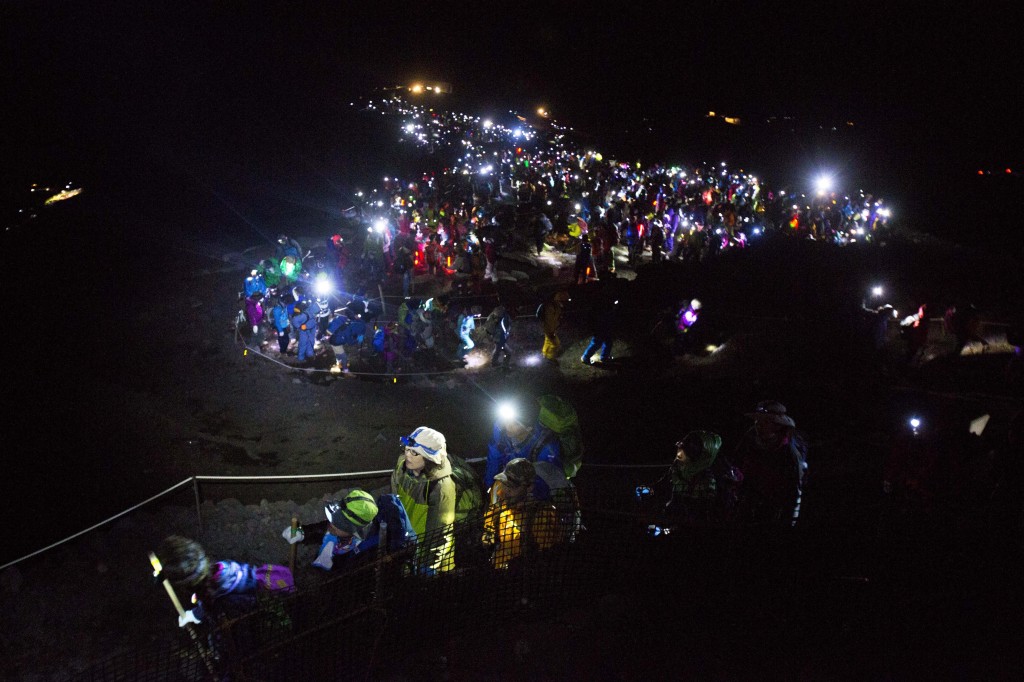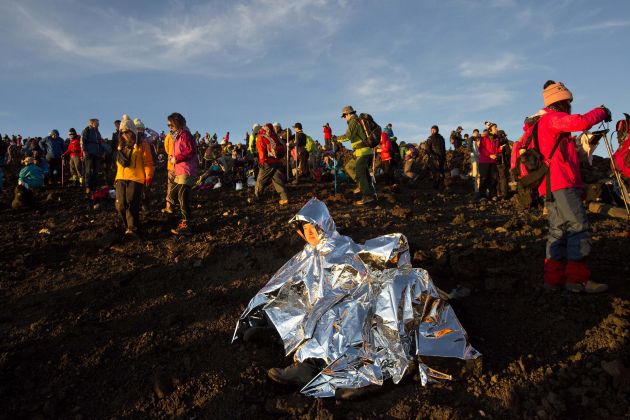
Fuji at night... like a downtown city. (Photo AP/ David Guttenfelder)
Mt Fuji is the country’s most famous goshintai (spirit body). Yet as a sacred mountain, its popularity is troublesome in terms of pressure on the environment. Its recent elevation to World Heritage status looks likely to exacerbate the situation, as the following article makes clear.
**********************************************
Mount Fuji’s World Heritage status worries some
By ELAINE KURTENBACH Japan Today SEP. 15, 2013
They trudge up well-trod cinder paths by the thousands, headlamps glowing in the dark, and then settle in, shivering, to await and cheer the sun’s blazing ascent over the horizon.
Climbing Mount Fuji, Japan’s most iconic landmark, is a group activity: Seldom is it climbed in solitude. The recent recognition of the 3,776-meter (12,388-foot) peak as a UNESCO World Heritage site has many here worried that will draw still more people, adding to the wear and tear on the environment from the more than 300,000 who already climb the mountain each year.

Fuji dawn (photo AP/David Guttenfelder)
Safety is another concern. At least seven people died and 70 were hurt climbing Fuji In 2012, and traffic jams of climbers in the pre-dawn darkness can add to the risks, says Shomei Yokouchi, governor of Yamanashi, the area to the west. The official climbing season runs July to August, and the trek — nine hours round trip in good weather — is especially treacherous other times of the year.
Mount Fuji’s near perfect cone was created by an eruption thousands of years ago that buried earlier peaks, and pilgrims have been climbing to it for centuries — though women have been allowed only since 1868. It towers over the Pacific coast, ringed by lakes, national parks, temples and shrines that are also part of the World Heritage site.
The new status, granted in June, will likely help area businesses — a welcome boost given the economic decline in most of rural Japan. Local authorities are puzzling, however, over how to preserve its natural beauty while improving traffic access and other facilities to accommodate the anticipated increase in visitors.
Some have suggested limiting access by raising tenfold the 1,000 yen ($10) climbing fee. But that might lead climbers to risk hypothermia by roughing it outdoors instead of staying in the 16 huts along the top of the trail, which charge up to $100 a night for cheek-by-jowl communal accommodations.

(Photo AP/ David Guttenfelder)
“With more foreigners visiting, we will need to think of improving the facilities,” Gov. Yokouchi says, noting that the installation of composting toilets has helped. “They are cleaner than before and the smell’s not so bad, but there are not enough of them.”
Then there’s the litter.
Each year 40,000 to 50,000 volunteers clean up garbage on the peak. Groups collected nearly 900 tons to prepare for June’s World Heritage vote by UNESCO, the U.N.‘s cultural organization.
The designation is something to be proud of, says Hisataka Kurosawa, a 16-year-old high school student who recently joined a group of volunteers who climbed part of a trail and then scrounged around a car park near a visitor center, collecting several big bags worth of oil cans, cigarette butts, car parts and candy wrappers.
“It’s getting polluted and so many people are running around. I’m a bit disappointed about that,” he says.
The volunteers were led by Toyohiro Watanabe, a former local government official who runs a civic group called Groundwork Mishima.
 It’s not just the crowds that worry him. He also frets over acid rain from sea water mixed with emissions from factories on the coast. Over invasive plant species, such as the bamboo grass that grows thick along the roadsides, obscuring some of the litter tossed from passing vehicles.
It’s not just the crowds that worry him. He also frets over acid rain from sea water mixed with emissions from factories on the coast. Over invasive plant species, such as the bamboo grass that grows thick along the roadsides, obscuring some of the litter tossed from passing vehicles.
Global warming may be contributing to huge fissures on Fuji’s slopes prone to erosion and landslides, he says. “Although Fuji has a power of its own, it is being influenced by global warming and other factors,” Watanabe says as he looks for trouble spots in some of the most frequented areas. “It is getting weaker.”
Though it last erupted in 1707, Mount Fuji remains an active volcano; Japanese seismologists watch it closely. The bigger risk, though, is from accidents.
Fuji is hardly steep, but its high elevation and fickle weather can make it a hazardous climb. “There are rock falls, and sometimes people are unable to get out of the way,” Yokouchi, the Yamanashi governor, says.
UNESCO has long acknowledged the risks to World Heritage sites, both from natural disasters and unsustainable levels of tourism. Even for a country as wealthy as Japan, tight budgets mean fewer resources available to support conservation.

Sunrise on Fuji is a big event – if you can see it for the crowds

Leave a Reply